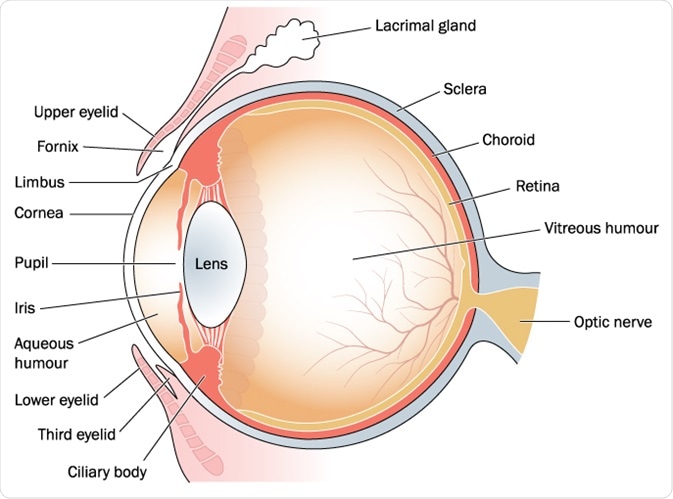The vitreous humor is an alternative biological matrix that is widely known for its usefulness in post-mortem forensic studies, particularly those involving drugs.

Image Credit: Blamb/Shutterstock.com
What is the vitreous humor?
Approximately 80% of the eyeball is made up of a gelatinous matrix otherwise known as the vitreous humor. Located behind the cornea and the lens, the vitreous humor is typically protected against contamination, putrefaction, and degradation by microorganisms.
While the vitreous humor is 98% water, some of the other components that comprise this biological matrix include inorganic salts, lipids, collagen fibers, and glucosaminoglycans.
Under normal circumstances, the vitreous humor plays a critical role in maintaining the retina in place and preserving the anatomical expansion and tonus of the globe. Typically, the average volume of the vitreous humor will be between 4 and 5 milliliters (mL), which is about 66% of the total volume of the eyeball.
Why analyze the vitreous humor?
Blood and/or urine may not be available for a given forensic investigation due to advanced putrefaction, skeletonization, exhumation, or air accidents. As a result, vitreous humor, which can remain available for analysis longer as compared to other types of matrices, is considered to be a valuable alternative for drug analysis.
Drugs and other xenobiotics within the bloodstream can penetrate through the blood-vitreous barrier and enter the vitreous humor through diffusion, hydrostatic pressure, osmotic pressure, convection, or active transport.
However, due to the lack of proteins present within the vitreous humor, drugs, which are often protein-bound and/or lipophilic, will be present at lower concentrations in the vitreous humor than in the blood.
Aside from this purpose, vitreous humor analysis can also be used in forensics to identify the amount of time that has elapsed from death to the time of autopsy. This method of determining the time and/or day of death is achieved by measuring the levels of potassium and other endogenous compounds including sodium, glucose, urea, and insulin, within the vitreous humor.
Collection of vitreous humor
During post-mortem sampling, the vitreous humor is typically extracted with a 25-gauge needle. Without applying too much pressure, the needle is introduced into the sclerocorneal junction and aspirated once the needle reaches the center of the eyeball. It is crucial to avoid causing any trauma to the eyeball during this procedure, as any damage to the retina can cause electrolyte levels of the vitreous humor to rise.
Typically, a volume of approximately 2 mL of vitreous humor that is clear in appearance is sufficient for biochemical analysis. Vitreous humor samples are often separated by gas chromatography (GC), high-performance liquid chromatography (HPLC), ultra-performance liquid chromatography (HPLC), and liquid chromatography (LC) methods and coupled with mass spectrometry (MS) detectors for analysis.
Stability advantages
Both animal and human studies have determined the vitreous humor matrix to exhibit superior stability properties as compared to the blood matrix for several different types of drugs. After administration through an intrajugular catheter, cocaine, benzoylecgonine, and ecgonine methyl ester in a swine model were all found to maintain stability within the vitreous humor at 8 hours post-mortem.
In fact, cocaine levels within the vitreous humor at 8 hours post-mortem were not significantly different as compared to those present within the femoral blood at the time of death.
In another animal study, 6-acetylmorphine (6-AM) levels were measured in the vitreous humor of sheep at 0, 7, 14, 21, 35, 54, and 84 days post-mortem. Whereas the 0 and 7-day samples were left at room temperature, all other samples were stored at -18°C. This study found that when sodium fluoride (NaF) was added to the vitreous humor samples, loss of 6-AM was less than 15%.
Other in vivo drug stability studies have found that MDMA and 6-monoaceethylmorphine (6-MAM) can also remain stable within the vitreous humor matrix. Similar results have also been demonstrated in the vitreous humor of humans.
For example, when vitreous humor samples were stored at -20°C for a maximum of 30 days post-mortem, morphine-3-glucuronide (M3G), morphine-6-glucuronide (M6G), morphine, codeine, codeine-6-glucuronide (C6G), and 6-MAM levels remained stable.
Ideal matrix for synthetic opioid cases
Over the past several years, a growing number of overdose-related deaths have been related to the misuse of synthetic opioids. As a result, detailed postmortem (PM) analysis and research on these substances have become tremendously important; however, the degradation and redistribution of drugs after death has caused several challenges.
The concentration ratios of fentanyl, for example, in the peripheral blood and liver, have been found to increase after death, thereby indicating the likelihood that fentanyl undergoes postmortem redistribution (PMR).
The vitreous humor has therefore been posited as a useful alternative in these cases, as this matrix and brain tissue are less likely to undergo PMR. In one recent study investigating the utility of vitreous humor in synthetic opioid deaths found that the synthetic opioids and metabolites of fentanyl, acetyl fentanyl, furanyl fentanyl, U-47700, 4-ANPP, and nor fentanyl could be accurately measured in vitreous humor samples.
It should be noted that while the vitreous humor matrix was found to be a viable alternative to blood, the lipophilic nature of most synthetic opioids resulted in a greater concentration of these drugs to be measured within the brain.

Image Credit: TheVisualsYouNeed/Shutterstock.com
References and Further Reading
- Wojtowicz, A., Wietecha-Polsuszny, R., & Snamina, M. (2020). Contemporary trends in drug analysis of vitreous humor: A critical review. Trends in Analytical Chemistry 129. doi:10.1016/j.trac.2020.115935.
- Pigaiani, N., Bertaso, A., De Palo, E. F., et al. (2020). Vitreous humor endogenous compounds analysis for post-mortem forensic investigation. Forensic Science International 310. doi:10.1016/j.forsciint.2020.110235.
- Chesser, R., Pardi, J., Concheiro, M., & Cooper, G. (2019). Distribution of synthetic opioids in postmortem blood, vitreous humor, and brain. Forensic Science International 305. doi:10.1016/j.forsciint.2019.109999.
Further Reading
Last Updated: Oct 21, 2020